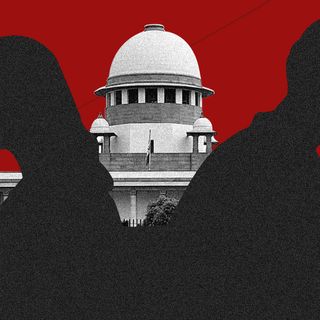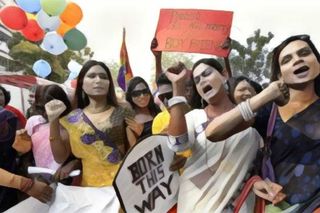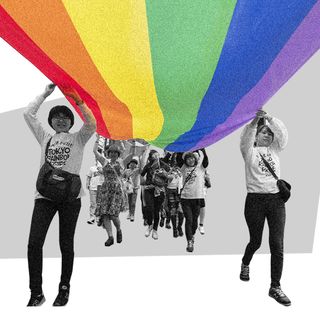
All the Arguments You Need to Address Transphobia
Trans rights are human rights, but a lot of people are socially conditioned to believe otherwise. Here are some arguments to help change their minds.

In our All The Arguments You Need series, we take on mindsets standing in the way of progress and rebut them with facts and logic.
Amid the cries of ‘Black Lives Matter,’ is nestled ‘Black Trans Lives Matter’ — calling attention to the injustice and violence that black trans women have faced while being at the forefront of the fight against queerphobia and police brutality. In India, trans individuals are marginalized: 96% are denied jobs, and 60% have no access to education. Plus, a new bill from the Indian state gives the government the power to arbitrate which trans people get to identify as trans.
In a largely heteronormative society, knowing and understanding the experiences of a minority gender is atypical. Here, we try to debunk the most basic arguments levied against the acknowledgment of trans individuals and their rights.
“There’s a reason we have the words man or woman — we are born male or female!”
Man/woman are terms that describe gender — they exist to denote the specific social behaviors, and roles individuals play in society, which makes gender a social construct. Human beings created gender by virtue of their shared understanding of the world.
Male/female are two biological sexes that individuals are born into — but sometimes, as an individual grows, they realize their gender identity is at odds with the sex they were assigned at birth, which means they are trans.
This realization is often accompanied by extreme unease with one’s body and gendered roles, which is known as gender dysphoria. According to the American Psychiatric Association, a dysphoric individual will face severe mental health issues and negative self-image if they are forced to live with a gender identity they do not feel comfortable in. This is also why trans individuals have significantly higher rates of suicide.
“Biological sex is binary and this is a scientific fact”
There are a number of ways that we are starting to understand that even biological sex may not be as binary as previously believed. For example, 2% of the population are born intersex, or with genitalia that doesn’t fit the male/female binary. This is a massive number — that’s the same amount of green-eyed people worldwide. After decades of intersex babies being subjected to sex reassignment surgeries at birth, intersex activists are now talking about the ethical problems with that practice, especially as it has no health benefits.
Another example: hormones are commonly believed to be deeply tied to biological sex. But we now know through endocrinologists that the levels of so-called ‘sex hormones,’ testosterone and estrogen, also exist on a spectrum, and are present in varying amounts in male and female bodies. Case in point: women with polycystic ovarian syndrome (PCOS) have high levels of testosterone in their bodies, but are still women.
Plus, a person may have high levels of testosterone merely because their body is not efficient at using the testosterone it produces. To combat this inefficiency, the body simply produces more to ensure proper usage. This does not change one’s sex, nor is there any medically accepted threshold for how much testosterone or estrogen qualifies someone as male or female.
Chromosomes are not binary either. There is a common misconception that XX/XY chromosomes are the only two combinations that exist to denote a male/female binary. But some people are born with XXY and XXX chromosomes too, and these are only two examples of multiple chromosomal variations Intersex individuals, for instance, may have four different types of chromosomal variations. Some intersex individuals with mostly male chromosomes can also carry fetuses to term if they have the anatomy necessary for pregnancy.
So in summary, even biological sex, which most people believe to be binary, is far more complicated than a strict male-female binary.
“Changing your body with surgery because you want to be someone else sounds like mental illness”
Gender dysphoria is not a mental illness, and neither is being trans, according to the World Health Organization. Dysphoria is a symptom that denotes unease in one’s gender identity, and if it is left unchecked, a trans person is a lot more likely to develop mental illnesses.
Gender reassignment surgeries and hormonal treatments are a set of medical procedures that are used to alter a trans individual’s physical appearance and sex organ characteristics to better fit the gender identity they identify with. It does not enable any illness and has a positive effect on trans individuals’ mental health. The likelihood of trans individuals needing mental health care drops around 8% post-gender-reaffirming surgeries, according to research from Yale School of Medicine.
Misgendering an individual, or using gender identity markers like names and pronouns that don’t belong to the gender they identify with, is a miserable experience. Trans individuals who are misgendered experience low self-esteem, loss of identity, anxiety, and feel dehumanized.
Related on The Swaddle:
Transgender Kids’ Brains Reflect Their Gender Identity in Structure and Function
“I don’t understand the difference between gay people and trans people!”
The LGBTQIA+ community does not only involve individuals with different sexualities, but also those from various gender identities. Gender and sexuality are extremely different — the latter denotes who one is attracted to, and the former denotes what people identify themselves with. A trans person can be straight, and a gay person can be trans.
“Trans men/women are not the same as ‘real’ men/women”
What it means to be a man or a woman is not fixed — there is no way to distill gender qualities that make a set of people a ‘real’ part of one gender identity, and others fake. There exist cisgender females who do not menstruate, live without ovaries and a uterus, and live without breasts. Some cisgender males cannot ejaculate sperm, cannot grow beards or any body hair. No one can decide if a person is male or female based on an arbitrary list of what components their body does or does not possess.
“But there’s a clear difference between the male brain and the female brain — you can’t switch”
The male brain and the female brain, fortunately, are myths. The brain is molded from birth depending upon the stimulus it receives. It is not biologically destined to develop a certain way — it develops according to the experiences it is subjected to. We only think that male and female brains exist because of ‘gender bombardment’ — or raising children in strict gender roles that they internalize and believe to be their truth.
Related on The Swaddle:
What a Transgender‑Friendly Health Care System Would Look Like
“I don’t see why I should make a specific effort to hire trans people”
As mentioned above, 96% of trans individuals are denied jobs, and 60% have no access to education. This is clearly because of discrimination against trans people, rather than a measure of how capable they are. Trans individuals are thus pushed into poverty, sex work, and begging, with no opportunity to explore their potential.
Making a concerted effort to both employ trans individuals, and to protect them at the workplace is a necessary step towards ending the discrimination they face.
“Why am I called cisgender? Do we really need all these terms?”
Cisgender just means that a person is comfortable with sex and gender that was assigned to them at birth.
There is no compulsion to re-frame one’s language in all walks of life, but we do need these terms. They may seem nitpicky or academic, but they are valuable means of spreading information and normalizing trans lives. There has never been any necessity to always introduce oneself as a cisgender individual, but one should know they are cisgender. This is to both volunteer information when asked, and to be aware of one’s privilege in a world that brutally marginalizes trans individuals.
“Let’s achieve equality for women first and then move on to trans people and their rights”
No. Each marginalized group is not a checklist to tick off while moving up the equality ladder. Achieving equality for ‘women first’ does not help, as it exlcudes trans women, who are also women. All marginalized groups need to move up the ladder together in order to achieve a balanced society, as fighting for one group while ignoring the other defeats the purpose of seeking an equal society.
“I support trans rights, but I don’t see why I have to treat them differently from cis people”
You have the right sentiment, but this isn’t an accurate analysis of how to undo years of oppression and brutality. Trans people continue to remain marginalized in ways cis people are not, which makes it necessary to take their unique circumstances into consideration when showing support. Plus, though trans people’s gender identity deserves acknowledgment and respect, trans people still are a part of their own historic, valuable culture and community, which they cannot be divorced from. We can do both — acknowledge trans people’s gender identity, and their identity as a trans individual.
Aditi Murti is a culture writer at The Swaddle. Previously, she worked as a freelance journalist focused on gender and cities. Find her on social media @aditimurti.
Related


Japanese Region Mie Criminalizes Outing LGBTQIA+ People Without Consent
